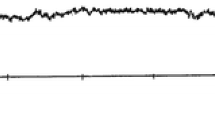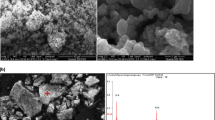Abstract
Antimonate (Sb(V)) and arsenate (As(V)) pollution frequently occur in aqueous environment and can be absorbed by poorly crystalline Fe minerals (i.e., ferrihydrite). In this study, the adsorption capacity and rate of Sb(V) and As(V) from water with fresh ferrihydrite were compared by establishing adsorption isotherms and kinetics, and the effects of ferrihydrite dosage, solution pH and humic substances on Sb(V) and As(V) adsorption were also investigated. The adsorption isotherms results showed that the equilibrium and maximum adsorption capacities of Sb(V) on ferrihydrite were approximately equal to those of As(V) under different temperatures. The results of adsorption kinetics showed that the adsorption rate of Sb(V) derived from the pseudo-second-order equation was much lower than that of As(V). In addition, the adsorption capacity and rate of Sb(V) and As(V) were greatly affected by various ferrihydrite dosage and solution pHs. The presence of humic acid and fulvic acid (FA) significantly affected the adsorption process of Sb(V) due to competition adsorption, whereas the adsorption properties of As(V) were little affected by FA under this experimental conditions.





Similar content being viewed by others
References
Dousova B, Buzek F, Herzogova L, Machovic V, Lhotka M (2015) Effect of organic matter on arsenic (V) and antimony (V) adsorption in soils. Eur J oil Sci 66:74–82
Fan J-X, Wang Y-J, Cui X-D, Zhou D-M (2013) Sorption isotherms and kinetics of Sb (V) on several Chinese soils with different physicochemical properties. J Soils Sediments 13:344–353
Ferguson JF, Gavis J (1972) A review of the arsenic cycle in natural waters. Water Res 6:1259–1274
Filella M, Belzile N, Chen Y-W (2002) Antimony in the environment: a review focused on natural waters: II Relevant solution chemistry. Earth Sci Rev 59:265–285
Freundlich U (1906) Die adsorption in lusungen. J Phys Chem 57:385–470
Fu Z, Wu F, Mo C, Deng Q, Meng W, Giesy JP (2016) Comparison of arsenic and antimony biogeochemical behavior in water, soil and tailings from Xikuangshan China. Sci Total Environ 539:97–104
Grosvenor A, Kobe B, Biesinger M, McIntyre N (2004) Investigation of multiplet splitting of Fe 2p XPS spectra and bonding in iron compounds. Surf Interface Anal 36:1564–1574
Guo X, Wu Z, He M, Meng X, Jin X, Qiu N, Zhang J (2014) Adsorption of antimony onto iron oxyhydroxides: adsorption behavior and surface structure. J Hazard Mater 276:339–345
Hammel W, Debus R, Steubing L (2000) Mobility of antimony in soil and its availability to plants. Chemosphere 41:1791–1798
Hasan Z, Jhung SH (2015) Removal of hazardous organics from water using metal-organic frameworks (MOFs): Plausible mechanisms for selective adsorptions. J Hazard Mater 283:329–339
Hayes KF, Papelis C, Leckie JO (1988) Modeling ionic strength effects on anion adsorption at hydrous oxide/solution interfaces. J Colloid Interface Sci 125:564–572
He M (2007) Distribution and phytoavailability of antimony at an antimony mining and smelting area, Hunan China. Environ Geochem Health 29:209–219
He M, Wang X, Wu F, Fu Z (2012) Antimony pollution in China. Sci Total Environ 421:41–50
Iervolino G, Vaiano V, Rizzo L, Sarno G, Farina A, Sannino D (2014) Removal of arsenic from drinking water by photo-catalytic oxidation on MoOx/TiO2 and adsorption on γ-Al2O3. J Chem Technol Biotechnol 91:88–95
Jia Y, Xu L, Wang X, Demopoulos GP (2007) Infrared spectroscopic and X-ray diffraction characterization of the nature of adsorbed arsenate on ferrihydrite. Geochim Cosmochim Acta 71:1643–1654
Karimian N, Johnston SG, Burton ED (2017) Antimony and arsenic behavior during Fe(II)-induced transformation of jarosite. Environ Sci Technol 51:4259–4268
Ko I, Davis AP, Kim J-Y, Kim K-W (2007) Effect of contact order on the adsorption of inorganic arsenic species onto hematite in the presence of humic acid. J Hazard Mater 141:53–60
Lan B, Wang Y, Wang X, Zhou X, Kang Y, Li L (2016) Aqueous arsenic (As) and antimony (Sb) removal by potassium ferrate. Chem Eng J 292:389–397
Langmuir I (1917) The constitution and fundamental properties of solids and liquids. J Frankl Inst 183:102–105
Lee CG, Alvarez PJJ, Nam A, Park SJ, Do T, Choi US, Lee SH (2017) Arsenic(V) removal using an amine-doped acrylic ion exchange fiber: kinetic, equilibrium, and regeneration studies. J Hazard Mater 325:223–229
Leuz A-K, Mönch H, Johnson CA (2006) Sorption of Sb (III) and Sb (V) to goethite: influence on Sb (III) oxidation and mobilization. Environ Sci Technol 40:7277–7282
Liu R, Xu W, He Z, Lan H, Liu H, Qu J, Prasai T (2015) Adsorption of antimony(V) onto Mn(II)-enriched surfaces of manganese-oxide and FeMn binary oxide. Chemosphere 138:616–624
Masscheleyn PH, Delaune RD, Patrick WH Jr (1991) Effect of redox potential and pH on arsenic speciation and solubility in a contaminated soil. Environ Sci Technol 25:1414–1419
Mitsunobu S, Harada T, Takahashi Y (2006) Comparison of antimony behavior with that of arsenic under various soil redox conditions. Environ Sci Technol 40:7270–7276
Mitsunobu S, Takahashi Y, Terada Y, Sakata M (2010) Antimony (V) incorporation into synthetic ferrihydrite, goethite, and natural iron oxyhydroxides. Environ Sci Technol 44:3712–3718
Muller T, Craw D, McQuillan AJ (2015) Arsenate and antimonate adsorption competition on 6-line ferrihydrite monitored by infrared spectroscopy. Appl Geochem 61:224–232
Oremland RS, Stolz JF (2003) The ecology of arsenic. Science 300:939–944
Pauling L (1933) The formulas of antimonic acid and the antimonates. J Am Chem Soc 55:1895–1900
Pierce ML, Moore CB (1982) Adsorption of arsenite and arsenate on amorphous iron hydroxide. Water Res 16:1247–1253
Qi P, Pichler T (2017) Competitive adsorption of As(III), As(V), Sb(III) and Sb(V) onto ferrihydrite in multi-component systems: implications for mobility and distribution. J Hazard Mater 330:142–148
Rakshit S, Sarkar D, Punamiya P, Datta R (2011) Antimony sorption at gibbsite–water interface. Chemosphere 84:480–483
Raven KP (1998) Jain, Amita., Loeppert, R.H., Arsenite and arsenate adsorption on ferrihydrite: kinetics, equilibrium, and adsorption envelopes. Environ Sci Technol 32:344–349
Russell JD (1979) Infrared spectroscopy of ferrihydrite: evidence for the presence of structural hydroxyl-groups. Clay Miner 14(2):109–114
Schwertmann Ut, Fischer W (1973) Natural “amorphous” ferric hydroxide. Geoderma 10:237–247
van Genuchten CM, Peña J (2016) Antimonate and arsenate speciation on reactive soil minerals studied by differential pair distribution function analysis. Chem Geol 429:1–9
Wang X, He M, Xi J, Lu X (2011) Antimony distribution and mobility in rivers around the world’s largest antimony mine of Xikuangshan, Hunan Province China. Microchem J 97:4–11
Wang H, Chen F, Mu S, Zhang D, Pan X, Lee D-J, Chang J-S (2013) Removal of antimony (Sb(V)) from Sb mine drainage: biological sulfate reduction and sulfide oxidation–precipitation. Bioresour Technol 146:799–802
Wang H, Zhang D, Mou S, Song W, Al-Misned FA, Mortuza MG, Pan X (2015) Simultaneous removal of tetracycline hydrochloride and As (III) using poorly-crystalline manganese dioxide. Chemosphere 136:102–110
Wang H, Wang YN, Sun Y, Pan X, Zhang D, Tsang YF (2018) Differences in Sb (V) and As (V) adsorption onto a poorly crystalline phyllomanganate (δ-MnO2): adsorption kinetics, isotherms, and mechanisms. Process Saf Environ Prot 113:40–47
Weng L, Van Riemsdijk WH, Hiemstra T (2009) Effects of fulvic and humic acids on arsenate adsorption to goethite: experiments and modeling. Environ Sci Technol 43:7198–7204
Wilson N, Craw D, Hunter K (2004) Antimony distribution and environmental mobility at an historic antimony smelter site New Zealand. Environ Pollut 129:257–266
Wilson SC, Lockwood PV, Ashley PM, Tighe M (2010) The chemistry and behaviour of antimony in the soil environment with comparisons to arsenic: a critical review. Environ Pollut 158:1169–1181
Wu F, Fu Z, Liu B, Mo C, Chen B, Corns W, Liao H (2011) Health risk associated with dietary co-exposure to high levels of antimony and arsenic in the world’s largest antimony mine area. Sci Total Environm 409:3344–3351
Xi J, He M, Lin C (2010) Adsorption of antimony (V) on kaolinite as a function of pH, ionic strength and humic acid. Environ Earth Sci 60:715–722
Acknowledgements
This work was financially supported by the China CPSF-CAS Joint Foundation for Excellent Postdoctoral Fellows (No. 2016LH0048), the Shandong Province Natural Science Foundation (No. ZR2016DQ08), the China Postdoctoral Science Foundation funded project (No. 2016M600829), the Research Grants Council of the Hong Kong SAR, China (No. 18202116), and the Dean’s Strategic Research Area Fund (No. DSRAF-6 SP1, DRF/SFRS-8), and the Internal Research Grant (No. RG 78/2015-2016R, RG 50/2017-2018R, RG 34/2017-2018R) of The Education University of Hong Kong.
Author information
Authors and Affiliations
Corresponding authors
Electronic supplementary material
Below is the link to the electronic supplementary material.
Rights and permissions
About this article
Cite this article
Wang, H., Tsang, Y.F., Wang, Yn. et al. Adsorption capacities of poorly crystalline Fe minerals for antimonate and arsenate removal from water: adsorption properties and effects of environmental and chemical conditions. Clean Techn Environ Policy 20, 2169–2179 (2018). https://doi.org/10.1007/s10098-018-1552-0
Received:
Accepted:
Published:
Issue Date:
DOI: https://doi.org/10.1007/s10098-018-1552-0




